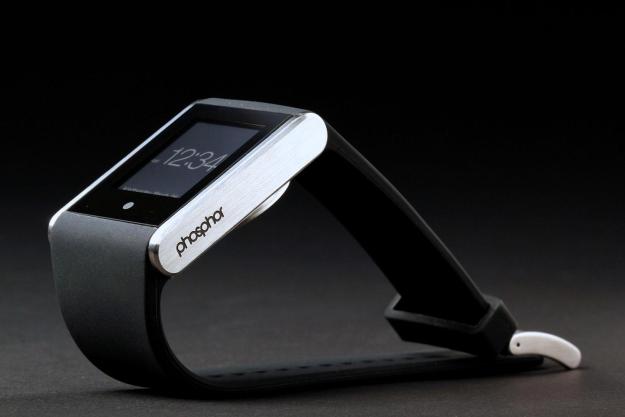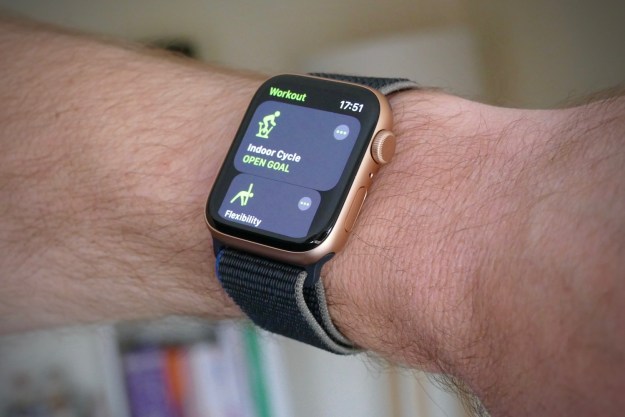
“Phosphor’s Touch Time is solidly built and simple to use. But $159 is a lot to ask in a smartwatch world for a watch that’s only slightly smart, with more than a few quirks.”
- Battery lasts “up to a year”
- Always-on monochrome display
- Solid build quality
- Supports multiple languages
- Limited functionality
- Finicky touchscreen
- Expensive
When you look at the current crop of smartwatches, with their heart rate monitors, cameras, and growing selection of apps, do you wish for something simpler, with a battery you don’t have to worry about charging every couple of days?
If so, Phosphor’s Touch Time might be worth considering—provided you’re looking for a touchscreen watch with a few extra features, rather than a connected device that delivers app notifications and messages to your wrist.
It looks as good as you’d expect from a bulky smartwatch, and is built well.
You may have heard of the Touch Time way back in mid-2012, when Phosphor raised over $300,000 on Kickstarter. Now the device is finally available to the general public for an asking price of $159—which frankly feels steep, given that you can pick up a Pebble Smartwatch for $150, or various wearable Sony or Samsung devices for not much more.
The Touch Time is a very solid-feeling watch with a tiny (1.5 inches) always-on monochrome LCD touchscreen and a few useful built-in apps. And it uses a standard watch battery, which the company says will last for up to a year. So there’s no need to recharge every day or two—a major pain point with the smartwatches we’ve seen so far.
It’s built well, but it’s also bulky
The first thing that’s obvious about the Touch Time when you pick it up is that Phosphor cares about build quality. The back and sides are brushed metal, and the front is the kind of slick glass you’d expect from a touchscreen device.
The watchband on the base model is silicone, rather than cloth or metal. But it does come in colors other than the basic black of our review unit (like orange and pale blue). And if you prefer a stainless steel band, you can pick up the Touch Time with one of those as well, for $200, which is a bit less than you’ll pay for the Pebble Steel.
Unfortunately, the Touch Time’s metal-and-glass design, combined with the necessary electronics, result in one bulky watch. It’s 10.7mm thick, which means it’s probably thicker than your smartphone, unless you’re due for an overdue upgrade.
The watch’s thickness is also made worse by its flat sides, which tend to catch on jackets, sweatshirts—basically anything with long sleeves—when you’re putting them on. This is true to some extent with any bulky watch. But with the Touch Time, it seems worse, likely due to the watch’s shape.
A tiny touchscreen
Watch screens have to be fairly small, but the 1.5-inch, 144×168 screen of the Touch Time is smaller (and lower-resolution) than even Sony’s 1.6-inch SmartWatch 2. The small screen issue, though, is alleviated somewhat by the fact that there isn’t a whole lot the watch can actually do, at least compared to smartwatches.
Compared to any smartwatch, the Touch Time can’t actually do much.
We’ll get to the apps and interface shortly, but it’s worth pointing out that the Touch Time can be tough to read in direct sunlight (like any LCD device), and the glass screen is prone to glare, which we discovered while driving and occasionally being blinded by reflected light from the sun or other cars.
There is a backlight, which is enabled by double tapping near the bottom of the screen. But while it’s bright enough for viewing the watch in the dark, it’s not even visible in daylight. And it only stays on for about three seconds, so be sure not to dawdle when checking your time.
Navigation works, as long as you go … slow
By default, the Touch Time’s screen is locked and will only show the time. To display anything else, or adjust settings, you have to press a silver circle on the face, below the screen, and wait a couple seconds for an unlock icon to appear. Then, swipe up from the bottom of the screen and the watch will unlock.

The screen also can be very hit-or-miss when it comes to registering swipes. We often found ourselves swiping several times before achieving the desired result. Swiping slowly (about half the speed that feels natural) helps, but still doesn’t always result in a successful swipe.
Swiping right to left takes you to the built-in apps. They’re shown as icons, four to a screen, and there are just two screens. Scrolling from left to right reveals calendar, alarm, stopwatch, and the world time app. Scrolling left to right (or right to left twice) reveals the calculator, a reminder app, a graphical lunar calendar, and settings, which lets you change sounds for the alarms and reminders, the language (there are seven choices), and inverse the screen so that the background is white, rather than black, which we found helped making the watch easier to read.
Swiping slowly helps, but still doesn’t always result in a successful swipe.
The calendar is basically just an at-a-glance look at the days of the current month, or the previous or upcoming months if you swipe up or down. There’s no way to, say, add appointments or reminders.
And the basic calculator, while functional, is spread across two screens, with the numbers on the top screen and all the functions on a different screen that you’ll have to swipe to get to. Needless to say, you won’t want to use the watch to do much more than calculate the occasional tip in a pinch.
Battery life is a full year, no recharging needed
Phosphor says the Touch Time will last up to a year with its standard watch battery. While we obviously can’t test that, longevity is arguably the device’s best feature—at least compared to smartwatches. Then again, compared to smartwatches (even bad ones) the Touch Time can’t actually do much. So as much as we love the Touch Time’s battery life, it’s not all that exciting compared to other watches with similar functionality.
Conclusion
The Phosphor Touch Time isn’t a bad product, although we’d like it more if it wasn’t so boxy and prone to snagging on our sweater sleeves.
What it is, though, is a solidly built touchscreen watch that gives you a few features that probably already exist on your smartphone. That makes its $160 price particularly tough to swallow these days when so much more (and better) functionality can be found in the devices many of us already carry with us.
In theory, the Touch Time might be a good option for those who don’t own a smartphone and don’t want to carry a low-end cellphone or a calculator around with them all the time. But that group is a dwindling number. And those tech-averse types will likely have less patience than us with the Touch Time’s finicky touchscreen. For them, the smarter (and definitely cheaper) option would be to pick up an old-school Calculator watch for under $50. Calculator watches from the likes of Casio were arguably the smartwatches of the 1980s. They may not have the touchscreen sleekness we’re used to in the 2010s, but they do provide much of the functionality of the Touch Time at a fraction of the price.
Highs
- Battery lasts “up to a year”
- Always-on monochrome display
- Solid build quality
- Supports multiple languages
Lows
- Limited functionality
- Finicky touchscreen
- Expensive
Editors' Recommendations
- Apple issues fix for ‘ghost touch’ problem on older Apple Watches
- The best smartwatches in 2024: our 13 favorites
- Does the Google Pixel Watch have fall detection? Not yet, but it’s coming soon
- Oppo’s latest Apple Watch clone has an important spec under the hood
- Touch ID might soon come to an Apple device you least expect






